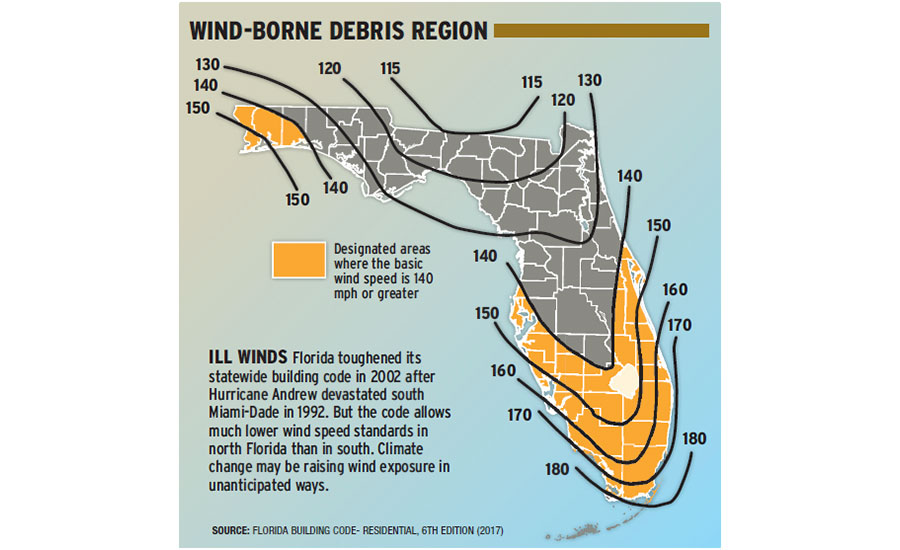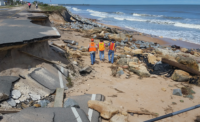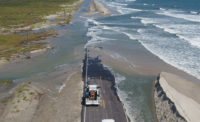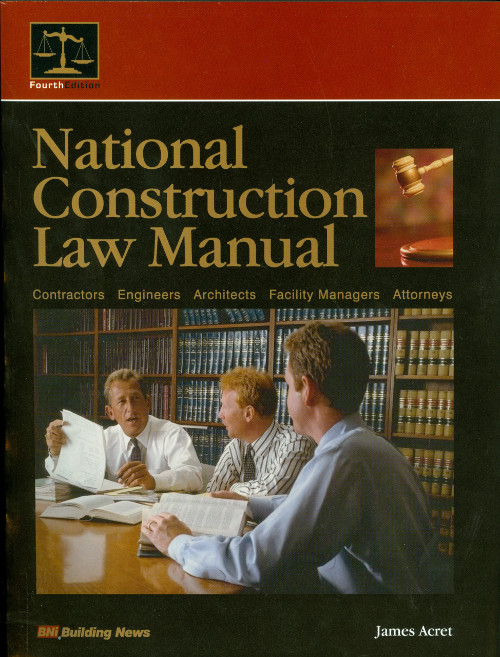10 Minutes With: Lessons of Resilience From Hurricane Michael

Florida toughened its statewide building code in 2002 after Hurricane Andrew devastated south Miami-Dade in 1992. But the code allows much lower wind speed standards in north Florida than in south. Climate change may be raising wind exposure in unanticipated ways.
SOURCE: FLORIDA BUILDING CODE- RESIDENTIAL, 6TH EDITION (2017)
With much of north Florida’s design and construction community engaged in damage assessment and recovery following Hurricane Michael’s Oct. 10 strike on the Panhandle and points north, ENR sat down Oct. 16 with Jason Bird, resilience practice leader for Jacobs, to learn how engineers can lead the way forward.
ENR: What lessons about resilience have we learned from Hurricane Michael?

Jason Bird: Coastal communities in Florida, on the Gulf Coast and elsewhere, have a lot of work to do. While there are still opportunities for improvement in policy and development codes to reflect the ever-changing conditions and growing climate-related risk, many of our clients are choosing to go beyond the minimum codes.
[They are] utilizing higher standards, including high-performance rating systems like Envision and Fortified, which address these threats. They see the value in a more collaborative, comprehensive and forward-looking approach focused on risk reduction, reliability and operational continuity for their communities and capital investment.
We need to take a more forward-looking approach to planning, design and construction.
ENR: Florida’s building code, which anticipates speeds tapering toward the north, seems to be predicated on an assumption that some areas will be less exposed than others to hurricanes. Does the experience with Michael suggest we are making the wrong assumptions about severe weather?
JB: In a general sense, history may not be a good indicator of what the future holds. As we learn more about climate change and increasing risk associated with severe weather events, we [realize] that the conditions we are facing today and into the future may be more dramatic than what we found in the past.
With Hurricane Michael setting records across the board—with wind speeds, formation, a path entering Georgia as a Category 3—these are things that have never happened before, so we recognize that we need to be thinking differently and looking at a different set of conditions that we’ll be facing in the future.
The historical record alone may not give us what we need to determine what we should be planning for. From that perspective, we need to consider risk, likelihood and the consequential impacts from various climate and weather hazards, and make smart decisions about where we invest, how we invest and how we build.
ENR: Do you have specific suggestions for areas of strategic planning we need to look at more closely?
JB: Legislation was passed in Florida a few years ago that included a “peril of flood” component—looking at the designation of physical adaptation action areas. The action areas were intended to be strategic areas that experience certain types of hazards or threats.
They could be designated to allow communities to focus investment and improvements to specifically address those threats. That’s one way state policy is helping focus on the high-risk areas, recognizing they require special attention.
ENR: Despite scientific evidence, climate change has been politicized. How do engineers meet their professional obligation to provide appropriate advice to clients in matters where the changing climate is a factor?
JB: We definitely see how climate change is politicized. It’s unfortunate, because it’s not a partisan issue. The threats of severe storms and climate don’t respect our artificial boundaries, our jurisdictions, etc.
Addressing that, our approach is twofold: [A] We don’t focus on the politics of it, what’s causing it, whether or not we believe certain parties and their opinions on it. [B] We start with hard science, understanding the conditions, and looking at the broader spectrum of available data.
Much of our work is based on historical data we have to work from, coupled with a strong understanding of the projections, be [they] temperature, rainfall, sea-level rise, storm severity, etc., to make a decision and full recommendation to our clients on capital investment.




